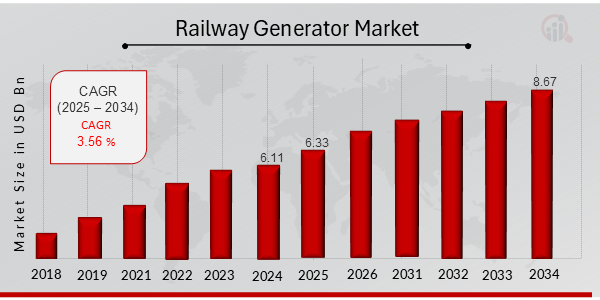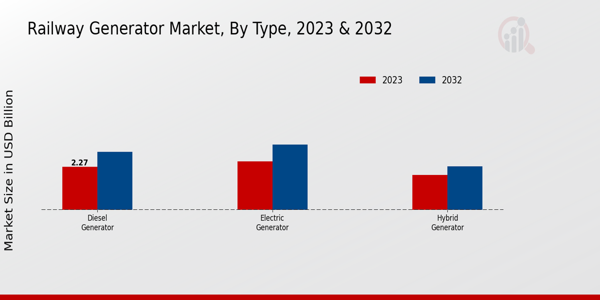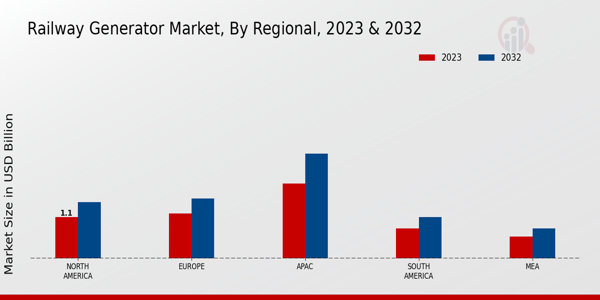Railway Generator Market Overview
As per MRFR analysis, the Railway Generator Market Size was estimated at 6.11 (USD Billion) in 2024. The Railway Generator Market Industry is expected to grow from 6.33 (USD Billion) in 2025 to 8.67 (USD Billion) till 2034, at a CAGR (growth rate) is expected to be around 3.56% during the forecast period (2025 - 2034).
Key Railway Generator Market Trends Highlighted
The global railway generator market is experiencing significant drivers that shape its growth. One key driver is the increasing demand for sustainable and efficient transportation options. As countries focus on reducing carbon footprints and transitioning to renewable energy sources, the shift towards electric trains and energy-efficient railway systems becomes vital.
Moreover, government initiatives for improving rail infrastructure and connectivity further bolster market growth. Opportunities within the market are abundant, particularly in emerging economies. The need for modernization of aging railway systems presents a chance for the introduction of advanced generator technologies.
Additionally, innovations in energy storage and hybrid systems offer pathways to enhance efficiency and reliability in rail operations. Expanding rail networks in urban areas to alleviate congestion also contributes to the potential for adopting new generator solutions that align with smart city initiatives.
In recent times, the market has seen a trend toward digitalization and automation, allowing for smarter energy management and monitoring systems. The integration of Internet of Things (IoT) technologies enhances operational efficiency and predictive maintenance, reducing downtime and operational costs.
Furthermore, the increased focus on safety standards and regulations is pushing manufacturers to develop more robust and secure railway generators. As the industry evolves, such trends are expected to continue, fostering a competitive landscape that encourages innovation and better service delivery across global railway networks.
The interplay between sustainability, technological advancement, and regulatory changes presents a dynamic environment for stakeholders looking to solidify their positions in this growing market.

Source: Primary Research, Secondary Research, MRFR Database and Analyst Review
Railway Generator Market Drivers
Growing Demand for Energy Efficiency and Sustainability
The global railway generator market is experiencing a significant shift towards energy efficiency and sustainability due to increased awareness regarding environmental issues.
Governments and railway companies are focusing on reducing carbon footprints and implementing sustainable practices in their operations. Railway generators are evolving to become more efficient, utilizing cleaner fuel sources and advanced technologies to minimize emissions.
The transition towards renewable energy sources is also gaining momentum as it aligns with global initiatives to combat climate change. This shift not only helps to meet regulatory compliance but also appeals to eco-conscious consumers and stakeholders.
Enhanced energy efficiency in railway systems not only reduces operational costs but also improves reliability and performance. As sustainability remains a focus area for the transportation sector, investments in advanced railway generator technologies are expected to surge.
The global awareness surrounding climate change and the urgency to transition towards greener alternatives highlights the importance of energy-efficient solutions in the railway industry. Consequently, this growing demand is anticipated to drive the global railway generator market, creating a trajectory for innovation and development in railway generators and related technologies.
The emphasis on sustainable rail transport solutions aids in aligning with government initiatives and public sentiments, further reinforcing the market's growth.
Increased Investment in Railway Infrastructure
In many regions, there is a significant increase in investment dedicated to upgrading and expanding railway infrastructure. This focus on enhancing the rail network facilitates better connectivity and efficiency, which in turn drives the global railway generator market.
Modernization projects often incorporate new technologies and energy-efficient systems, including advanced generators that meet the demands of modern rail operations. As governments prioritize infrastructure development, the push for reliable and efficient power generation solutions becomes a pivotal aspect, consequently spurring growth in this market.
Rising Electrification of Railway Networks
The rise in the electrification of railway networks is becoming a significant driver in the global railway generator market. As countries look for ways to enhance operational efficiency and reduce dependency on fossil fuels, electrification is increasingly seen as a viable solution.
This trend not only enhances the performance of trains but also reduces operational costs and environmental impact. The adoption of electric trains leads to the demand for advanced railway generators to support these networks, driving innovations in technology and manufacturing.
The investments allocated for electrification projects are likely to bolster the railway generator market, positioning it for sustainable growth.
Railway Generator Market Segment Insights:
Railway Generator Market Type Insights
The global railway generator market showcases a diverse landscape segmented by type. This segmentation includes diesel generators, electric generators, and hybrid generators, each contributing significantly to the overall market dynamics.
The diesel generator segment was valued at 2.27 USD billion in 2023 and is anticipated to grow to 3.06 USD billion by 2032, demonstrating a strong dominance within the market due to its reliability and established technology in railway operations, particularly in regions where electric infrastructure is less developed.
Electric generators followed closely, starting at a valuation of 2.57 USD billion in 2023 and expected to reach 3.45 USD billion by 2032, reflecting a significant shift towards more environmentally friendly alternatives that leverage electricity as a cleaner energy source for railway systems.
Meanwhile, the hybrid generator segment, valued at 1.85 USD billion in 2023 and projected to rise to 2.29 USD billion by 2032, represented a growing trend where efficiency and sustainability converge, offering rail operators the flexibility of using multiple power sources to reduce emissions and operational costs.
The market growth is supported by rising regulations aimed at decreasing carbon footprints and increasing investments in railway electrification and modernization initiatives.
Each type plays a crucial role in the overall growth of the global railway generator market, with electric generators gaining traction as global energy policies shift towards renewable sources. The segment insight reveals a competitive landscape driven by technological advancements and regulatory frameworks, ensuring sustained growth and opportunities in the years to come.
The global railway generator market data indicates a balanced but competitive scenario among these types, with diesel generators maintaining majority holding, while electric and hybrid generators are on the rise, thus reshaping the future of railway power solutions.

Source: Primary Research, Secondary Research, MRFR Database and Analyst Review
Railway Generator Market Power Rating Insights
The global railway generator market showcases diverse power rating categories that play a pivotal role in the industry. Among these, generators rated up to 200 kW are essential for lightweight and smaller rail applications, ensuring operational efficiency in urban transit systems.
The segment 201 kW to 500 kW serves medium-scale operations, bridging the gap between light and heavy-duty generators, while 501 kW to 1000 kW caters to high-demand applications often found in freight and longer-distance passenger trains.
The segment above 1000 kW is significant for large engines and heavy freight operations, providing robust power solutions necessary for extensive rail networks. Overall, the market growth in these categories underlines the importance of adapting to varied energy needs, with ongoing innovations contributing to improved efficiency and sustainability in rail transport.
Railway Generator Market End Use Insights
The global railway generator market is expected to witness significant growth driven by the diverse applications within its end use segment, which primarily includes passenger railways, freight railways, and urban transit systems.
Passenger railways play a crucial role in this market, supporting mobility and serving a major portion of urban and intercity transport needs. Freight railways, known for their efficiency in transporting goods over long distances, significantly contribute to the market due to the rising demand for bulk transportation solutions.
Urban transit systems are becoming increasingly essential for sustainable urban development, making them a vital area for innovation and investment as cities expand. The interplay among these segments fosters competition and leads to technological advancements, paving the way for enhanced operational efficiencies.
Overall, the global railway generator market segmentation reveals a dynamic and evolving landscape driven by the need for reliable and efficient rail systems amid growing environmental concerns and logistical challenges.
Railway Generator Market Installation Type Insights
The global railway generator market is witnessing a robust segmentation based on installation type, including both mobile and stationary generators. This market is poised for considerable growth, driven by the increasing demand for reliable and efficient power generation in rail transport.
Among the segments, the mobile installation type holds a significant share due to its flexibility and ability to meet dynamic energy needs on the go. This adaptability is essential for rail networks that require power solutions that can be easily relocated.
Meanwhile, the stationary generators offer consistent power for fixed installations, playing a vital role in ensuring uninterrupted operations at railway stations and depots. The combination of these installation types contributes to the overall global railway generator market revenue, supported by trends emphasizing sustainability and innovation in rail systems.
Challenges such as cost and the need for advanced technology advancements remain, but opportunities in expanding infrastructures and modernization of rail operations continue to drive market expansion. Overall, the global railway generator market statistics reveal a promising landscape for stakeholders within the installation type segment.
Railway Generator Market Application Insights
The segmentation within this market includes railway electrification, emergency power supply, and onboard power supply, each contributing significantly to the overall market dynamics. Railway electrification remains vital, as the shift towards electric trains enhances efficiency and reduces carbon emissions, aligning with global sustainability goals.
Emergency power supply also holds a significant place, ensuring operational continuity during unforeseen power outages, which is critical for safety and reliability in train operations. Onboard power supply is essential for powering vital systems within trains, including lighting, HVAC, and communications, enhancing passenger comfort and service delivery.
With a growing emphasis on electrification and safety, the global railway generator market is expected to witness consistent growth rates, driven by advancements in technology and rising demand for efficient train systems. The market data reflects these trends, highlighting the importance of each application in maintaining industry standards and responding to emerging challenges.
Railway Generator Market Regional Insights
North America held a valuation of 1.1 USD billion, while Europe was slightly higher at 1.2 USD billion. The Asia-Pacific (APAC) region dominated with 2.0 USD billion, showcasing its significant contribution to the market growth, driven by increased rail infrastructure investments and modernization efforts.
In contrast, South America, valued at 0.8 USD billion, exhibits potential for growth in railway electrification and expansion projects. The Middle East and Africa (MEA) region accounted for 0.59 USD billion but presents opportunities for development due to rising demand for efficient transportation systems.
The global railway generator market segmentation clearly indicates that APAC not only commands the majority holding but also plays a crucial role in the industry's expansion due to its vast population and urbanization trends.
As global railway networks evolve, the focus on sustainable energy solutions will likely enhance market dynamics, facing challenges such as infrastructure investments while capitalizing on rising electrification projects across all regions.

Source: Primary Research, Secondary Research, MRFR Database and Analyst Review
Railway Generator Market Key Players and Competitive Insights:
The global railway generator market is characterized by intense competition, driven by the growing emphasis on energy efficiency, safety, and innovation in rail transportation. As the demand for sustainable and reliable energy sources for railway systems escalates, numerous players are vying for market share, leading to advancements in technology and product offerings.
The market is influenced by factors such as regulatory frameworks, the push for renewable energy, and the increasing requirement for efficient infrastructure. Companies in this landscape are continuously working on enhancing their offerings and delivering value-added services to differentiate themselves, catering to both passenger and freight rail applications.
This competitive environment fosters a landscape ripe for collaboration and partnerships, further propelling innovation and growth within the sector. Rolls-Royce boasts a strong presence in the global railway generator market, recognized for its commitment to delivering high-performance and reliable power solutions for locomotive applications.
The company leverages its advanced engineering capabilities and heritage in the aviation sector to bring cutting-edge technology to the rail industry. With a focus on reducing emissions and improving energy efficiency, Rolls-Royce is positioned as a leader in developing state-of-the-art generator systems that meet the stringent demands of modern rail operations.
The company's strengths lie in its research and development initiatives, robust product portfolio, and adept understanding of customer needs, enabling it to create tailored solutions that enhance the overall efficiency and reliability of railway systems. Rolls-Royce's strategic partnerships and collaborations further bolster its market position, positioning it favorably against competitors.
Caterpillar has established itself as a formidable player in the global railway generator market, leveraging its extensive experience in heavy machinery and power generation solutions. The company is known for its durable and efficient generators, specifically designed to withstand the rigorous demands of railway applications, providing reliability in various operating environments.
Caterpillar's strength lies in its comprehensive service capabilities, including maintenance support and training for customers, ensuring seamless operation and longevity of its generator systems.
The company's wide-ranging distribution network allows it to maintain a significant market presence, providing clients with easy access to its innovative technologies and solutions. Additionally, Caterpillar is recognized for its commitment to sustainability, emphasizing the development of environmentally friendly power generation systems that align with global trends towards greener rail transport solutions.
This focus on performance and sustainability reinforces Caterpillar's position in the competitive landscape of the railway generator market.
Key Companies in the railway generator market Include:
- Rolls-Royce
- Caterpillar
- Perkins
- MTU Onsite Energy
- Kohler
- Wärtsilä
- ABB
- Cummins
- Siemens
- Alstom
- Atlas Copco
- Volvo Penta
- Mitsubishi
- Daimler
- GE
Railway Generator Market Developments
Recent developments in the global railway generator market continue to highlight technological advancements and strategic expansions among major companies. Rolls-Royce and Siemens have been focusing on enhancing their generator efficiency and reliability for railway applications, while ABB has made strides in electrification solutions for rail networks.
Caterpillar and MTU Onsite Energy are also innovating with sustainable energy solutions to meet increasing regulatory demands for greener technologies. Notably, Wärtsilä and Kohler are investing in research and development to diversify their product offerings for hybrid and electric train systems.
In terms of mergers and acquisitions, the industry has seen heightened activity, with firms seeking to strengthen their market positions. Cummins recently announced a strategic acquisition aimed at enhancing its offerings in the rail generator sector.
Alstom's collaboration with Ge to develop advanced railway systems is gaining traction, further indicating a trend toward consolidation in the market. Growth in the valuation of key players is influencing market dynamics, with companies like Volvo Penta and Mitsubishi reporting significant financial upticks, bolstering investor confidence and interest in this evolving sector.
Railway Generator Market Segmentation Insights
Railway Generator Market Type Outlook
- Diesel Generator
- Electric Generator
- Hybrid Generator
Railway Generator Market Power Rating Outlook
- Up to 200 kW
- 201 kW to 500 kW
- 501 kW to 1000 kW
- Above 1000 kW
Railway Generator Market End Use Outlook
- Passenger Railways
- Freight Railways
- Urban Transit Systems
Railway Generator Market Installation Type Outlook
Railway Generator Market Application Outlook
- Railway Electrification
- Emergency Power Supply
- Onboard Power Supply
Railway Generator Market Regional Outlook
- North America
- Europe
- South America
- Asia Pacific
- Middle East and Africa
| Report Attribute/Metric |
Details |
|
Market Size 2024
|
6.11 (USD Billion)
|
|
Market Size 2025
|
6.33 (USD Billion)
|
|
Market Size 2034
|
8.67 (USD Billion)
|
|
Compound Annual Growth Rate (CAGR)
|
3.56% (2025 - 2034)
|
|
Report Coverage
|
Revenue Forecast, Competitive Landscape, Growth Factors, and Trends
|
|
Base Year
|
2024
|
|
Market Forecast Period
|
2025 - 2034
|
|
Historical Data
|
2019 - 2023
|
| Market Forecast Units |
USD billion |
| Key Companies Profiled |
RollsRoyce, Caterpillar, Perkins, MTU Onsite Energy, Kohler, Wärtsilä, ABB, Cummins, Siemens, Alstom, Atlas Copco, Volvo Penta, Mitsubishi, Daimler, GE |
| Segments Covered |
Type, Power Rating, End Use, Installation Type, Application, Regional |
| Key Market Opportunities |
Growing demand for electrification, Advancements in renewable energy integration, Increasing focus on energy efficiency, Expansion of high-speed rail networks, Government investment in railway infrastructure |
| Key Market Dynamics |
Growing demand for electrification, Advancements in generator technology, Increasing rail infrastructure investments, Focus on energy efficiency, Need for renewable energy sources |
| Countries Covered |
North America, Europe, APAC, South America, MEA |
Frequently Asked Questions (FAQ) :
The global railway generator market is expected to be valued at 8.67 USD billion by the year 2034.
The expected CAGR for the global railway generator market from 2025 to 2034 is 3.56%.
In 2023, the APAC region held the largest share of the global railway generator market, valued at 2.0 USD billion.
The Electric Generator segment is expected to reach a market value of 3.45 USD billion by 2032.
Major players in the global railway generator market include Rolls-Royce, Caterpillar, Perkins, and Cummins.
The Diesel Generator segment is projected to be valued at 3.06 USD billion in 2032
The South American market for Railway Generators is expected to grow to 1.1 USD billion by 2032.
The Hybrid Generator segment is anticipated to be valued at 2.29 USD billion in 2032.
The North America Railway Generator Market is expected to grow from 1.1 USD billion in 2023 to 1.5 USD billion by 2032.
Key growth drivers for the global railway generator market include the increasing demand for efficient railway systems and modernization efforts.

















